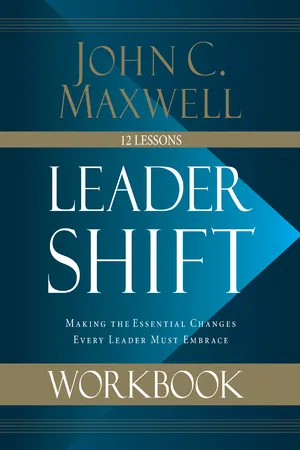
Leadershift Workbook
Making the Essential Changes Every Leader Must Embrace
- 224 pages
- English
- ePUB (mobile friendly)
- Available on iOS & Android
About this book
Lead-er-shift [verb]: The act of nimbly adapting one’s leadership in the midst of rapid change.
The term leadershift may be new to you, but the climate of change that demands it is not. As a leader, you already know that it takes more than staying the course to be successful. The key to not just surviving but to continual innovation, improvement, and influence is to learn how to leadershift.
In the Leadershift Workbook, based on the bestselling book of the same name, author John C. Maxwell helps leaders make the changes the current fast-paced environment demands. He begins by helping leaders embrace seven principles to face every situation with flexibility and confidence:
- Continually learn, unlearn, and relearn
- Value yesterday, but live in today
- Rely on speed, but thrive on timing
- See the big picture as the picture keeps getting bigger
- Live in today, but think about tomorrow
- Move forward courageously in the midst of uncertainty
- Realize today’s best will not meet tomorrow’s challenges
In each of the lessons in this workbook, John shares the critical shifts he has personally made over the course of his long and successful leadership career, including the Adaptive Shift from Plan A to Option A, the Production Shift from Ladder Climbing to Ladder Building, and the Influence Shift from Positional Authority to Moral Authority. These leadershifts will change the way you think, act, and ultimately lead so you can be proactive and successful in an ever-changing world.
Designed for use with the Leadershift book (9780718098506).
Frequently asked questions
- Essential is ideal for learners and professionals who enjoy exploring a wide range of subjects. Access the Essential Library with 800,000+ trusted titles and best-sellers across business, personal growth, and the humanities. Includes unlimited reading time and Standard Read Aloud voice.
- Complete: Perfect for advanced learners and researchers needing full, unrestricted access. Unlock 1.4M+ books across hundreds of subjects, including academic and specialized titles. The Complete Plan also includes advanced features like Premium Read Aloud and Research Assistant.
Please note we cannot support devices running on iOS 13 and Android 7 or earlier. Learn more about using the app.
Information
LESSON ONE
WHY EVERY LEADER NEEDS TO
LEADER SHIFT
Management systems and processes tend to be linear. They assume that similar inputs will result in similar outputs. In many situations, this holds true. Leadership, however, requires a more nuanced view of the world because it involves people: what motivates them, what their interests are, and how engaged they become. Mechanical systems may be linear but as soon as the human element becomes involved the system becomes both complex and adaptive.1
FAST IS FASTER—FORWARD IS SHORTER
CONSIDER
Table of contents
- Cover Page
- Title Page
- Copyright Page
- Ebook Instructions
- Contents
- Acknowledgments
- Lesson 1: Why Every Leader Needs to Leadershift
- Lesson 2: Soloist to Conductor
- Lesson 3: Goals to Growth
- Lesson 4: Perks to Price
- Lesson 5: Pleasing People to Challenging People
- Lesson 6: Maintaining to Creating
- Lesson 7: Ladder Climbing to Ladder Building
- Lesson 8: Directing to Connecting
- Lesson 9: Team Uniformity to Team Diversity
- Lesson 10: Positional Authority to Moral Authority
- Lesson 11: Trained Leaders to Transformational Leaders
- Lesson 12: Career to Calling
- About the Author
- Endnotes